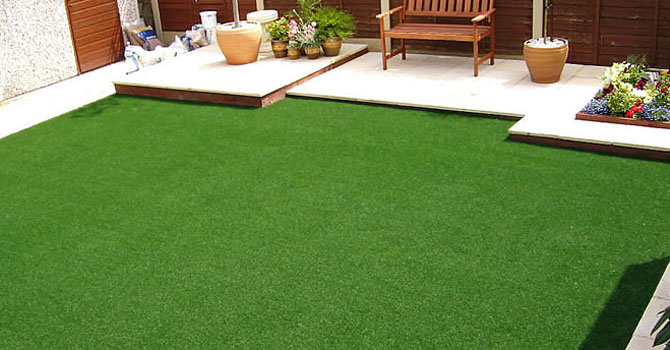Who doesn’t like a sprawling lawn right outside their house? But sometimes, even if you want to extend the area of your lawn, the soil or the texture of the surface may not be suitable for growing grass naturally. In such cases installing artificial grass is a viable option.
Available in a range of textures and shades, artificial grass is easy to maintain and looks vibrant round-the-year. The touch and feel of the grass is pretty close to natural grass. If you are also planning to use it, read this post to do synthetic grass installation the right way.

Things required:
- artificial turf
- artificial grass installer
- spade or turf cutter
- weed-suppressing membrane
- sand, crushed stones or grit
- utility knife
- piece of wood or flat board level
- adhesive (optional)
- shock-absorbent material (optional)
- plank of wood
- nails
- hammer
- lawn seed spreader (for silica sand)
- silica sand
- coarse broom
- warm, soapy water (optional)
1. Before you begin, make sure you choose the area where water pipes and cables are laid deep down, much below the point till where you plan to dig.
2. Use a spade and remove stones, sporadically grown grass or any other material lying underneath. Using an edging system is advised to make sure you do not end up digging to deep or too less. Ideally, depth of 2 inches is considered.
3. Lay down a type 1 stone to fix drainage problems, if any. Poor drainage system may result in clogging, especially during rainy season. If there aren’t any drainage issues, artificial grass installation gets even easier as then you can lay it directly onto compacted sod.
4. Cut away the outer perimeters (a right-angled edge or corner) to make a symmetrical sloping edge measuring 40 mm. This makes for a more natural look.
5. Apply around 6 mm of sand or granite dust. Use a piece of wood or timber to evenly distribute the dust or sand all over the area of application to make the surface as smooth as possible. The depth should not be more than 20 mm if you are using sand and there should not be any obstructions or debris underneath.
6. Once you have completed compressing and levelling the base, apply a weed membrane. This prevents growth of weed, fungus etc and facilitates drainage. If required, use a gaffer’s tape to join the edges.
7. Now take the artificial turf and unroll it over the area. Do it carefully so as not to disturb the placement of the weed membrane. Trim the excess artificial grass once you have positioned the turf correctly.
8. Sand dressing is the last step of this process. Use a blower and stiff brush or a lawn fertiliser spreader to apply kiln sand to the turf (approximately 6-8 kgs of sand per square meter). Use an artificial grass installer and move it slowly but firmly all over the area.

